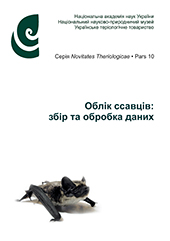|
menu
 about Novitates
about Novitates
 issue contents
issue contents
 editorial board
editorial board
 author guides
author guides
issues
 pars 18 (2025) pars 18 (2025)
 pars 17 (2025) pars 17 (2025)
 pars 16 (2023) pars 16 (2023)
 pars 15 (2022)
pars 15 (2022)
 pars 14 (2022)
pars 14 (2022)
 pars 13 (2022)
pars 13 (2022)
 pars 12 (2021)
pars 12 (2021)
 pars 11 (2020)
pars 11 (2020)
 pars 10
(2017)
pars 10
(2017)
 pars 9
(2015)
pars 9
(2015)
 pars
8 (2012)
pars
8 (2012)
 pars 7
(2007)
pars 7
(2007)
 pars 6 (2001)
pars 6 (2001)
 pars
5 (2005)
pars
5 (2005)
 pars 4 (2001)
pars 4 (2001)
 pars 3 (2003)
pars 3 (2003)
 pars
2 (2000)
pars
2 (2000)
 pars
1 (2000)
pars
1 (2000)



|
 bibliography bibliography
Mammal Census: Data Collection and Processing: collection of scientific articles. Compiled and edited by I. Zagorodniuk. Ukrainian Theriological Society and National Museum of Natural History, NAS of Ukraine. Kyiv, 2017. 226 pp. (Series: Novitates Theriologicae; Pars 10).
ISSN 2709-4928 (online)
ISSN 2709-491X (print)
licence: CC BY-SA
doi: http://doi.org/10.53452/nt10
Summary. The tenth issue of the Bulletin Novitates Theriologicae includes materials of the Theriological Schools-Seminars devoted to the methods of fauna accounting. The collection of papers is based on the results and ideas formulated at the IX Theriological School held in the Roztochia Nature Reserve. The results of that school and subsequent annual theriological schools became the basis for this (10th) issue, for which new materials were prepared. Among the latter are developments in research planning and large mammal census, as well as methodological approaches to data processing. In total, the current issue contains 24 materials grouped into 4 sections. This is the anniversary (X) edition, and the Chronicle section provides an outline of its history. The issue was prepared on the initiative of the Council of the Theriological School and the editorial board of the Proceedings of the Theriological School.
Licence. Issue is freely
available under CC BY-SA 4.0 license.
Full version of issue (pdf
11.6 mb) >>>
Ukrainian version of the web-page >>>
Foreword |
|
|
|
|
|
Zagorodniuk, I. Methods of theriofauna surveys and the Theriological School: From ideas to knowledge (editor's note) |
5–8 |
>>> |
|
|
|
Chapter 1. Field research: organisation, work technique |
|
|
|
|
|
Drebet, M. Research on the small mammal fauna by analysis of pellets of birds of prey: algorithms of collection and analysis |
10–17 |
>>> |
Evstafiev, I. Theriological studies: epizootological aspects (Introduction to epizootology) |
18–32 |
>>> |
Zagorodniuk, I. Baits for trapping small mammals: universal and selective |
33–41 |
>>> |
Kondratenko, O. Comprehensive ecological and faunal study of micromammals as a census group at biostations |
42–53 |
>>> |
Markovska, O. The main vital marking methods of small mammals |
54–59 |
>>> |
Miropolsky, V. Photographing of wild animals and traces of their life in the field |
60–69 |
>>> |
Roman, E. The experience of making and use of homemade camera traps on the base of film cameras |
70–75 |
>>> |
Selyunina, Z. The system of long-term mammalian monitoring in the Black Sea Biosphere Reserve: census methods |
76–82 |
>>> |
|
|
|
Chapter 2. Techniques of census of different mammalian groups |
|
|
|
|
|
Zhyla, S. A brief review of census methods of the beaver’s abundance and selection of the most effective method for conditions of Ukraine |
84–94 |
>>> |
Zagorodniuk, I. Census and monitoring of bats without targeted trapping: possibilities of conducting and issues of distant diagnostics |
95–107 |
>>> |
Zagorodniuk, I. Census and trapping methods of dendrophilous rodents |
108–113 |
>>> |
Zizda, Yu. The main types of field research on dendrophilous rodents and collection of primary information about the presence and biology of species |
114–117 |
>>> |
Petrushenko, Ya. The problem of objectivity of bat census in caves |
118–120 |
>>> |
Rizun, E. Census of game mammals on hunting grounds (a review of methods) |
121–132 |
>>> |
Stetsula, N. The algorithm of census of small mammals on trap-lines in different types of forest ecosystems |
133–141 |
>>> |
Sheihas, I. Methods of wolf number census in conditions of game husbandries: principles, algorithm, and key features |
142–149 |
>>> |
|
|
|
Chapter 3. Accumulation and processing of data |
|
|
|
|
|
Evstafiev, I. Zoological databases: step-by-step database creation based on Excel spreadsheets |
151–175 |
>>> |
Zagorodniuk, I., Naglov, V. The index of habitat preference in ecological studies of species and of the structure of communities |
176–182 |
>>> |
Zagorodniuk, I. Zoological collections as a source of information about the state and changes of fauna, communities, and populations |
183–189 |
>>> |
Nebogatkin, I. An express key to mammals of Ukraine based on bone remains from bird pellets and excrements of predators |
190–205 |
>>> |
Khoyetskyy, P. Game fauna census in the “2-tp – hunting” statistical report: features, advantages, disadvantages |
206–216 |
>>> |
|
|
|
Chapter 4. Chronicle and information |
|
|
|
|
|
Zagorodniuk, I. A history of the edition Novitates Theriologicae (Pars 1–10) |
218–225 |
>>> |
|